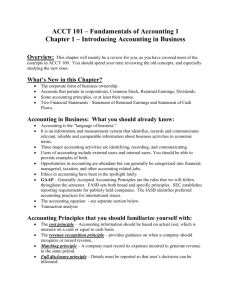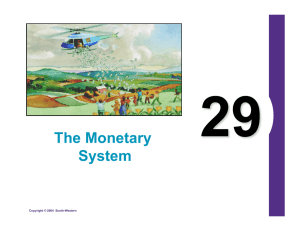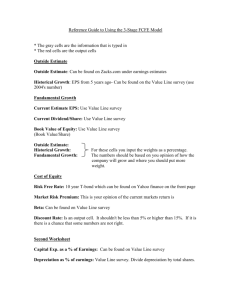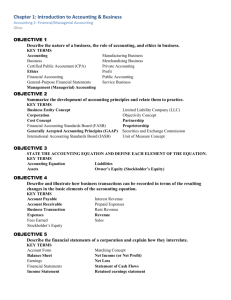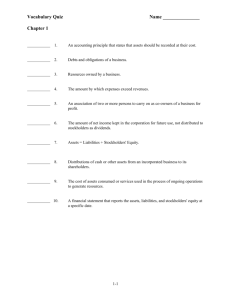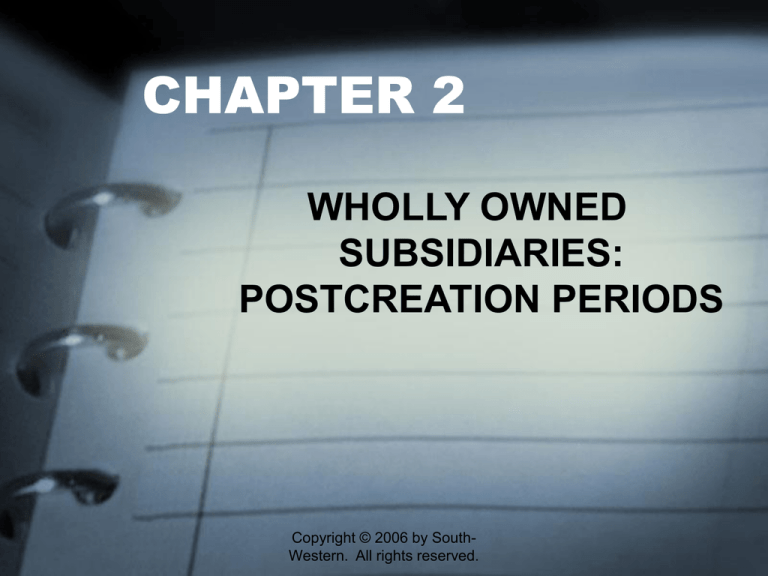
CHAPTER 2
WHOLLY OWNED
SUBSIDIARIES:
POSTCREATION PERIODS
Copyright © 2006 by SouthWestern. All rights reserved.
FOCUS OF CHAPTER 2
• Ways to Value the Parent’s Investment
Account in POSTCREATION Periods
• Cost Method vs. Equity Method Driven
Consolidation Procedures
–
–
Income Statements
Statements of Retained Earnings
• Parent-Company-Only (PCO) Statements
–
Articulation with Consolidated Statements
Copyright © 2006 by South-Western. All rights reserved.
The Cost Method:
How It Works
• It is cash basis driven:
– Record income at the parent level ONLY
when sub declares a dividend.
– Ignore sub’s earnings.
– Do NOT ignore sub’s losses.
– Write-down investment ONLY IF value
has been impaired.
– Write-downs result in a NEW cost basis.
Copyright © 2006 by South-Western. All rights reserved.
The Cost Method:
How It Works (cont.)
• It is a one-way street!
The investment can be written down—
but NEVER written up.
Copyright © 2006 by South-Western. All rights reserved.
The Cost Method:
Pros & Cons
• Pros:
–
Minimal G/L bookkeeping by parent.
– Simple consolidation procedures.
• Cons:
–
Overly conservative valuation.
– Parent can manipulate its reported
income.
– PCO statements—if used internally or
issued—may be of limited value.
Copyright © 2006 by South-Western. All rights reserved.
The Cost Method:
MAJOR Point of Interest
• Although the parent CAN manipulate its
OWN reported net income, it can NEVER
manipulate CONSOLIDATED net income.
Copyright © 2006 by South-Western. All rights reserved.
The Equity Method:
How It Works
• It is accrual basis driven:
– Record income at the parent level
based on sub’s earnings and losses—
an AUTOMATIC VALUATION
TECHNIQUE.
– Sub’s dividends reduce the parent’s
investment (the parent has less
invested).
Copyright © 2006 by South-Western. All rights reserved.
The Equity Method:
How It Works (cont.)
It is a two-way street!
The investment can be:
(1) written up AND
(2) written down.
Copyright © 2006 by South-Western. All rights reserved.
The Equity Method:
Pros and Cons
• Pros:
–
Based on economic activity—not the
parent-controlled dividend policy.
–
Has 2 built-in checking figures.
• Cons:
–
Entails continual bookkeeping.
– Unnecessary work if PCO statements
are not used internally or issued to
outsiders.
Copyright © 2006 by South-Western. All rights reserved.
The Equity Method:
MAJOR Point of Interest
• Compared with the cost method, the
consolidation entry under the equity
method has a “new kid on the block.”
• A posting must be made to eliminate the
subsidiary’s beginning retained earnings.
Copyright © 2006 by South-Western. All rights reserved.
The Cost Method:
Things to Remember in Consolidation
• Consolidated NET INCOME does NOT
equal the parent’s NET INCOME.
P
S
$54,000 + $24,000
Sub’s Divies
- $4,000 =
CON.
$74,000
• Consolidated RETAINED EARNINGS
does NOT equal the parent’s RETAINED
EARNINGS.
P
S
$103,000 + $20,000 =
Copyright © 2006 by South-Western. All rights reserved.
CON.
$123,000
The Cost Method:
Things to Remember in Consolidation
• NONE of the sub’s beginning or ending
RETAINED EARNINGS is eliminated in
consolidation.
P
S
$54,000 + $20,000
CON.
$74,000
=
• ONLY the parent’s DIVIDENDS are
reported in the consolidated column.
P
S
Sub’s Divies
$(51,000) + $(4,000) - $4,000 =
Copyright © 2006 by South-Western. All rights reserved.
CON.
$(51,000)
The Equity Method:
Things to Remember in Consolidation
• Consolidated net income EQUALS the
parent’s net income.
P
CON.
$74,000 = $74,000
• Consolidated retained earnings EQUALS
the parent’s retained earnings.
P
CON.
$123,000 = $123,000
Copyright © 2006 by South-Western. All rights reserved.
The Equity Method:
Things to Remember in Consolidation
• ALL of sub’s beginning & ending RETAINED
EARNINGS are eliminated in consolidation.
P
S
Sub’s R.E.
CON.
$123,000
$20,000 - DIVIDENDS
$20,000
= are
$123,000
• ONLY
the+ parent’s
reported in the consolidated column (also
occurs under the cost method).
P
S
Sub’s Divies
$(51,000) + $(4,000) - $4,000
=
Copyright © 2006 by South-Western. All rights reserved.
CON.
$(51,000)
PCO Statements: Presented in
Notes to the Consolidated Statements
• PCO statements are mandatory for
publicly owned banks and S&Ls (SEC
rules).
– Can ONLY use the equity method.
• Equity method results in 100% articulation
between PCO statements and
consolidated statements:
– SAME net income amounts.
– SAME retained earnings amounts.
Copyright © 2006 by South-Western. All rights reserved.
PCO Statements: Presented in
Notes to the Consolidated Statements
• Retained Earnings Available for
Dividends:
Based on the parent’s G/L amount—
NOT on the consolidated retained
earnings amount.
– Use of the equity method in PCO
statements produces IDENTICAL
retained earnings amounts.
– Use of the cost method in PCO
statements creates CONFUSION.
–
Copyright © 2006 by South-Western. All rights reserved.
Consolidation: The Most Important
Point of All on Investment Basis
• The consolidated statement amounts
are identical whether the parent uses
the cost method or the equity method—
this holds true for ALL 3 statements.
Copyright © 2006 by South-Western. All rights reserved.
Total Investment Loss Situations:
Equity Method Procedures
• Parent Has GUARANTEED Sub’s Debt:
– NO interruption occurs in the
application of the equity method.
– Parent can lose more than it has
invested—parent is “on the hook.”
Copyright © 2006 by South-Western. All rights reserved.
Total Investment Loss Situations:
Equity Method Procedures (cont.)
• Parent Has NOT GUARANTEED Sub’s
Debt:
– Discontinue equity method when sub’s
equity reaches zero—resume ONLY
WHEN sub’s equity becomes positive.
– Parent can NEVER lose more than it
has invested.
Copyright © 2006 by South-Western. All rights reserved.
AROI Versus IRR:
They Serve Entirely Different Purposes
Annual Return on Investment (AROI):
• Tells what was actually earned on an
investment EACH year.
• Based on actual GAAP net income.
• Can be used to calculate an average AROI
covering several years.
1
2
3
AVG.
18% + 12% + 15% = 45%; 45%/3 = 15%
Copyright © 2006 by South-Western. All rights reserved.
AROI Versus IRR:
They Serve Entirely Different Purposes
• Internal Rate of Return (IRR):
– An assumed rate covering SEVERAL
years.
• Based on cash flows for those years.
– CANNOT show what was actually
earned in any GIVEN year.
• Artificially assumes that each year’s
unrecovered investment (at B-O-Y)
earns the SAME rate.
Copyright © 2006 by South-Western. All rights reserved.
AROI vs. IRR:
They Serve Entirely Different Purposes
AROI
Purpose Tells what was
served: actually earned
for a given
year.
Short- An average AROI
coming: covering several
years is less
reliable than
IRR.
Copyright © 2006 by South-Western. All rights reserved.
IRR
Tells what was
or will be
earned over
several years.
Reveals nothing
about a given
year.
Review Question #1
Under the COST METHOD, a sub’s
DIVIDENDS would:
A.
B.
C.
D.
E.
NOT be eliminated in consolidation.
Be the parent’s investment income.
Reduce the parent’s investment.
Increase the parent’s investment.
None of the above.
Copyright © 2006 by South-Western. All rights reserved.
Review Question #1
With Answer
Under the COST METHOD, a sub’s
DIVIDENDS would:
A.
B.
C.
D.
E.
NOT be eliminated in consolidation.
Be the parent’s investment income.
Reduce the parent’s investment.
Increase the parent’s investment.
None of the above.
Copyright © 2006 by South-Western. All rights reserved.
Review Question #2
Under the COST METHOD, a sub’s
LOSSES would:
A. Never reduce the parent’s income.
B. Always reduce the parent’s income.
C. Always reduce the parent’s
investment.
D. Always be eliminated in consolidation.
E. None of the above.
Copyright © 2006 by South-Western. All rights reserved.
Review Question #2
With Answer
Under the COST METHOD, a sub’s
LOSSES would:
A. Never reduce the parent’s income.
B. Always reduce the parent’s income.
C. Always reduce the parent’s
investment.
D. Always be eliminated in consolidation.
E. None of the above.
Copyright © 2006 by South-Western. All rights reserved.
Review Question #3
Under the EQUITY METHOD, a sub’s
DIVIDENDS would:
A.
B.
C.
D.
E.
NOT be eliminated in consolidation.
Be the parent’s investment income.
Reduce the parent’s investment.
Increase the parent’s investment.
None of the above.
Copyright © 2006 by South-Western. All rights reserved.
Review Question #3
With Answer
Under the EQUITY METHOD, a sub’s
DIVIDENDS would:
A.
B.
C.
D.
E.
NOT be eliminated in consolidation.
Be the parent’s investment income.
Reduce the parent’s investment.
Increase the parent’s investment.
None of the above.
Copyright © 2006 by South-Western. All rights reserved.
Review Question #4
Under the EQUITY METHOD, a sub’s
LOSSES would:
A. Never reduce the parent’s income.
B. Normally reduce the parent’s income.
C. Always reduce the parent’s
investment.
D. Always be eliminated in consolidation.
E. None of the above.
Copyright © 2006 by South-Western. All rights reserved.
Review Question #4
With Answer
Under the EQUITY METHOD, a sub’s
LOSSES would:
A. Never reduce the parent’s income.
B. Normally reduce the parent’s income.
C. Always reduce the parent’s
investment.
D. Always be eliminated in consolidation.
E. None of the above.
Copyright © 2006 by South-Western. All rights reserved.
Review Question #5
On 1/1/04, Paxco invested $500,000 in
Saxco (100%-owned). For 2004, Saxco: (1)
earned $70,000, (2) declared dividends of
$40,000, and (3) paid dividends of
$30,000. What amounts does Paxco
report?
Cost Equity
Investment income for 2004.....
Investment in Saxco at Y/E......
Retained earnings increase.......
Copyright © 2006 by South-Western. All rights reserved.
Review Question #5
With Answer
On 1/1/04, Paxco invested $500,000 in
Saxco (100%-owned). For 2004, Saxco: (1)
earned $70,000, (2) declared dividends of
$40,000, and (3) paid dividends of
$30,000. What amounts does Paxco
report?
Cost Equity
Investment income for 2004..... $40,000
Investment in Saxco at Y/E...... $500,000
Retained earnings increase.......
$40,000
Copyright © 2006 by South-Western. All rights reserved.
$70,000
$530,000
$70,000
Review Question #6
A parent can lose MORE THAN than it
has invested:
A. Only under the cost method.
B. Only under the equity method.
C. Under either the cost or equity
methods.
D. Only if the subsidiary is not
consolidated.
E. None of the above.
Copyright © 2006 by South-Western. All rights reserved.
Review Question #6
With Answer
A parent can lose MORE THAN than it has
invested:
A. Only under the cost method.
B. Only under the equity method.
C. Under either the cost or equity
methods.
D. Only if the subsidiary is not consolidated.
E. None of the above.
Copyright © 2006 by South-Western. All rights reserved.
Review Question #7
Parent-company-only (PCO) statements
are usually presented in notes only when:
A.
B.
C.
D.
E.
The parent uses the cost method.
The parent uses the equity method.
The subsidiary is not consolidated.
The SEC’s rules require them.
None of the above.
Copyright © 2006 by South-Western. All rights reserved.
Review Question #7
With Answer
Parent-company-only (PCO) statements
are usually presented in notes only
when:
A.
B.
C.
D.
E.
The parent uses the cost method.
The parent uses the equity method.
The subsidiary is not consolidated.
The SEC’s rules require them.
None of the above.
Copyright © 2006 by South-Western. All rights reserved.
Review Question #8
When a parent-sub relationship exists,
STATE LAWS require dividends to be
based on the:
Parent’s retained earnings.
Sub’s retained earnings.
Consolidated retained earnings.
The lower of the parent’s OR the
consolidated retained earnings.
E. None of the above.
A.
B.
C.
D.
Copyright © 2006 by South-Western. All rights reserved.
Review Question #8
With Answer
When a parent-sub relationship exists,
STATE LAWS require dividends to be
based on the:
Parent’s retained earnings.
Sub’s retained earnings.
Consolidated retained earnings.
The lower of the parent’s OR the
consolidated retained earnings.
E. None of the above.
A.
B.
C.
D.
Copyright © 2006 by South-Western. All rights reserved.
End of Chapter 2
• Time to Clear Things Up—
Any Questions?
Copyright © 2006 by South-Western. All rights reserved.

